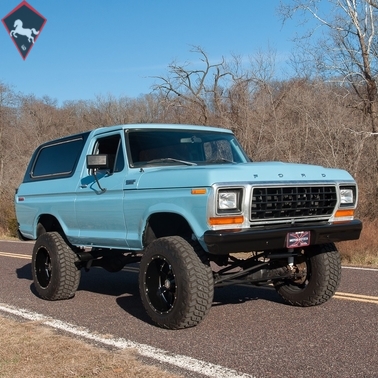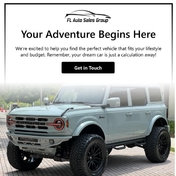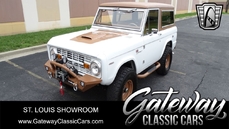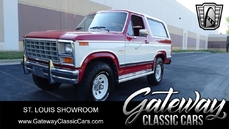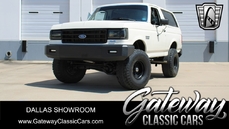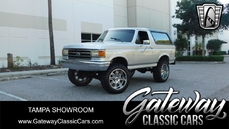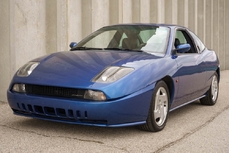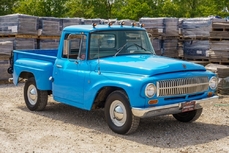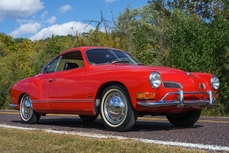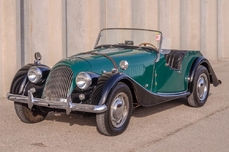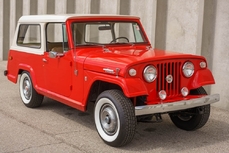Ford Bronco 351 CID V-8 1979
General description :
1979 Ford Bronco Custom 4×4
Final model year for second-generation Bronco
Very desirable factory 4-speed and factory air conditioning Bronco
Four-inch lift kit
Light Medium Blue exterior (code K) with white hardtop and black interior
Cleveland 351 CID V-8 engine (VIN code H) with dual exhausts
Rare Borg-Warner T-18 four-speed manual transmission (code F) and 3.50 limited-slip differential (code H2)
35” tires and American Racing wheels
New paint and interior
104-inch wheelbase
Own this Vehicle from $389 per month-call 636-600-4600
No longer content with its multi-purpose vehicle being the runt of the Big Three, Ford upped the ante in 1978 with its Bronco model. MotoeXotica Classic Cars is pleased to present this 1979 Ford Bronco Custom 4×4 with the very desirable 4-speed transmission and air conditioning. Nineteen seventy-nine was the second-generation Bronco’s last model year.
The Bronco Custom served as the standard-trim model. Rectangular headlights became standard for all 1979 Broncos. Made in Ford’s Wayne, Michigan (VIN code L) truck factory in March 1979, this example is finished in Light Medium Blue (code K). This Bronco was delivered new to our local St. Louis, Missouri region (trim code 55).
The truck’s paint and trim are in overall very good order, with only minor imperfections noted at close range. This Bronco’s bodywork is straight, has a four-inch lift kit. The engine bay is very tidy, the battery appears new, the rear cargo area is quite tidy (and comes with a new spare tire with cover) and the truck’s chrome bumpers are in very good condition.
Under the hood is a Cleveland 351 CID V-8 (VIN code H) engine breathing via dual exhausts. For 1979, Ford added emissions controls to its light-truck engines; the Bronco gained a catalytic converter (among other equipment). Backing this engine is a Borg-Warner T-18 four-speed manual transmission (code F). Only 21.2 percent of 1979 Broncos came with a manual transmission and even more rare with factory air conditioning!
Broncos in 1979 were fitted exclusively with four-wheel drive; a part-time system was standard with a New Process 205 gear-driven transfer case with the option of permanent four-wheel drive and a New Process 203 chain-driven transfer case. Out back is a 3.50:1 limited-slip rear end (code H2). The second-generation Bronco is fitted with a coil-sprung Dana 44 front axle and has a leaf-sprung Ford nine-inch axle in the rear (similar to the later first-generation Broncos). The first- and second-generation Broncos are the only versions designed with non-independent front suspension (solid front axle).
This truck rolls on new Terra Rader light truck tires, size 35×12.50R20 at all four wheels. Each big donut wraps around a chromed and vented American Racing wheel. The wheels are in excellent condition.
Inside, a new black interior looks great! The front and rear bench seats, shot through with white and gray, look great, the black carpet and mats look excellent, A thick-rimmed, three-spoke aftermarket steering wheel faces the driver. The instrument panel, with its trim accents, features a full array of gauges and is in satisfactory order, as are the two-tone inner door panels. Completing the interior is a modern AM/FM stereo with CD player. While a two-seat interior remained standard, the 11-inch wider interior allowed for a three-passenger front bench seat; with a folding and removable rear seat, the Bronco became a six-passenger vehicle for the first time.
In place of a model-specific chassis, the Bronco was adapted directly from the Ford F-Series, becoming a shortened version of the F-100 4×4. Originally intended for a 1974 launch, the second-generation Bronco (named “Project Shorthorn” during its development) was postponed to 1978 in response to fuel economy concerns related to the 1973 fuel crisis; the second-generation Bronco was released for sale after development was nearly finalized on its 1980 successor.
While most other vehicles focused on downsizing, the second-generation Bronco added 12 inches of wheelbase, approximately 28 inches of length, 11 inches of width, and four inches of height; based on powertrain configuration, the Bronco gained 1,100 to 1,600 pounds of curb weight over its predecessor.
The second-generation Bronco marks the introduction of design commonality with the Ford F-Series and retained the lift-off hardtop bodystyle for the three-door wagon, though now fiberglass over the rear seat area only (and not a full-length steel top). Replacing the multiple body configurations of the first generation, the second-generation Bronco was offered solely as a three-door wagon with a lift-off rear hardtop. As with its chassis, the second-generation Bronco derives much of its body from the F-Series truck line, sharing the doors, front roofline and sheetmetal, and interior with the F-Series.
Retaining the wagon body from its predecessor, Ford designers shifted to a lift-off hardtop from behind the B-pillars. Designed by Dick Nesbitt, the configuration achieved higher commonality with the F-100 (sharing the doors and overhead roof stamping); attention was focused on minimizing leaks around the top seals (a problem related to the design of the K5 Blazer hardtop of the time). In a configuration similar to the Ford LTD Country Squire, the rear window glass rolled down into the tailgate (via a dash-mounted switch or from using the key on the outside), allowing the tailgate to fold down.
In spite of its short production cycle (only two years), the second-generation Bronco proved successful, overtaking the Blazer and Ramcharger in sales for the first time; initial demand was so strong that customers waited several months to receive vehicles from dealers. Ford sold more than 145,000 examples during 1978 and 1979.
Competition to this Bronco in 1979 included Chevy’s K5 Blazer, Dodge’s Ramcharger, GMC’s K5 Jimmy, Jeep’s Cherokee and Plymouth’s Trailduster.
If you seek a good-looking, classic 4×4 with a few modern tweaks, then this is the one for you. Ford and 4×4 SUV fans, you should really do yourselves a favor and visit today to check out this ’79 Bronco at MotoeXotica Classic Cars.
VIN: U15HLEH5517
This truck is currently located at our facility in St. Louis, Missouri. Current mileage on the odometer shows 26,541 miles. It is sold as is, where is, on a clean and clear, mileage exempt title. GET OUT AND DRIVE!!!
https://www.motoexotica.com/inventory/listing/1979-ford-bronco-custom-4x4/
1979 Ford Bronco 351 CID V-8 is listed sold on ClassicDigest in Fenton (St. Louis) by for Not priced.
Car Facts
Car type : Car Make : Ford Model : Bronco Model Version : 351 CID V-8 Engine size : 0.0 Model Year : 1979 Location : Fenton (St. Louis)
Sold
Seller Information
Sold
People who viewed this Ford Bronco also viewed similar Ford listed at ClassicDigest
Other cars listed for sale by this dealer
About Ford
Ford, founded in 1902, has arguably changed the history of automotive world more than any other car manufacturer by introducing the first people's car Model T in 1908. They had produced more than 15 million cars by the end of the production in 1927, by which T had become obsolete.Ford launched the first low priced V8 engine powered car in 1932. 1932 V8 was an instant hit with superior handling and performance to many far more expansive cars of the day. No wonder 32 V8 Ford has become such a favourite among hot rodders around the world with 32 Deuce coupe as their icon.
During the war Ford completely shut down civilian vehicle production to dedicate all its resources to the Allied war efforts (1942-45) They used to build B-24 bombers, aircraft engines, jeeps, M-4 tanks, military trucks and Bren-gun carriers and more than 30,000 super-charged Rolls Royce Merlin V-12 engines for Mosquito and Lancaster bombers as well as P-51 Mustang fighters. After the war Ford cars in the USA got bigger and flashier along with their competitors. In the 60's Ford was back in the forefront again when introducing their commercial hit Mustang in 1964. Mustang was so popular the competition had to follow Ford's example and the ponycar phenomenon took over the US. Over the years the ponies grew some muscles until the oil crisis kill finally killed them off.
In the sixties Ford rushed into international motor sports scene with a fury. After unsuccessful Ferrari takeover, when Enzo Ferrari had cut the deal off with Henry Ford II making the latter absolutely boil with fury, Ford turned to Lola in UK to produce a Ferrari beating long distance racer after. The collaboration between Ford and Lola created the mighty Ford GT40 that absolutely beat Ferrari in Le Mans 24 numerous times.
In Europe, Ford introduced some of the most epic race and rally cars of the 60's based on humble family sedans; Cortina GT, Lotus Cortina, Escort Twin Cam, and Escort 1600RS with the iconic Cosworth BDA engines.
Today classic Fords are extremely popular with enthusiasts and a great selection of classic Fords can be found for sale at www.ClassicDigest.com
